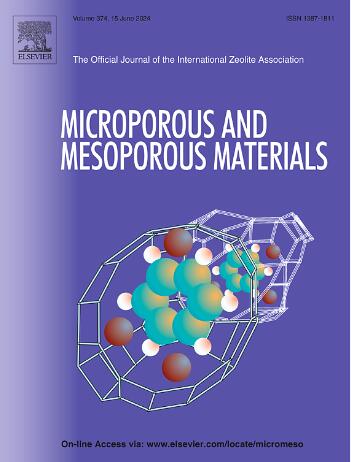Surface chemical modulation of nitrogen-doped microporous carbon for efficient removal of H2S and CO2: The effect of nitrogen functionality
IF 4.8
3区 材料科学
Q1 CHEMISTRY, APPLIED
引用次数: 0
Abstract
The removal of hydrogen sulfide (H₂S) and carbon dioxide (CO₂) is of paramount importance for mitigating environmental pollution. However, due to the difficulty in accurately controlling the surface chemistry, the performance of carbon materials in the simultaneous removal of H₂S and CO₂ remains relatively limited. Herein, nitrogen-doped microporous carbon with well-developed pore structure was prepared through a combination of hydrothermal synthesis and molten salt method. The impact of nitrogen-doped surface chemistry on the removal performance for H₂S and CO₂ at room temperature was primarily studied. Owing to its abundant micropores and ultramicropores, the material possesses sufficient basic sites that can effectively remove CO₂. Pyrrolic nitrogen serves as the primary basic site during CO₂ adsorption, which exhibits an excellent CO₂ adsorption capacity of 136.97 mg CO₂/g. The high nitrogen content provides a strongly alkaline environment conducive to the dissociation of H₂S on the carbon surface, with pyrrolic nitrogen being the main basic site during the catalytic oxidation of H₂S. The large pore volume offers sufficient storage space for desulfurization products, enabling a sulfur capacity of 2.56 g H₂S/g. DFT calculations reveal that pyrrolic nitrogen undergoes the largest change in charge before and after the adsorption of CO₂ and H₂S, due to its strong adsorption effect on both gases. In the presence of both CO₂ and H₂S, competition for active sites leads to a decline in the removal performance for both gases. This work holds significant implications for the design of materials for the simultaneous removal of CO₂ and H₂S.

求助全文
约1分钟内获得全文
求助全文
来源期刊

Microporous and Mesoporous Materials
化学-材料科学:综合
CiteScore
10.70
自引率
5.80%
发文量
649
审稿时长
26 days
期刊介绍:
Microporous and Mesoporous Materials covers novel and significant aspects of porous solids classified as either microporous (pore size up to 2 nm) or mesoporous (pore size 2 to 50 nm). The porosity should have a specific impact on the material properties or application. Typical examples are zeolites and zeolite-like materials, pillared materials, clathrasils and clathrates, carbon molecular sieves, ordered mesoporous materials, organic/inorganic porous hybrid materials, or porous metal oxides. Both natural and synthetic porous materials are within the scope of the journal.
Topics which are particularly of interest include:
All aspects of natural microporous and mesoporous solids
The synthesis of crystalline or amorphous porous materials
The physico-chemical characterization of microporous and mesoporous solids, especially spectroscopic and microscopic
The modification of microporous and mesoporous solids, for example by ion exchange or solid-state reactions
All topics related to diffusion of mobile species in the pores of microporous and mesoporous materials
Adsorption (and other separation techniques) using microporous or mesoporous adsorbents
Catalysis by microporous and mesoporous materials
Host/guest interactions
Theoretical chemistry and modelling of host/guest interactions
All topics related to the application of microporous and mesoporous materials in industrial catalysis, separation technology, environmental protection, electrochemistry, membranes, sensors, optical devices, etc.
 求助内容:
求助内容: 应助结果提醒方式:
应助结果提醒方式:


